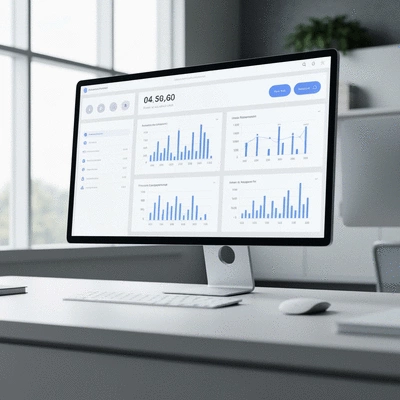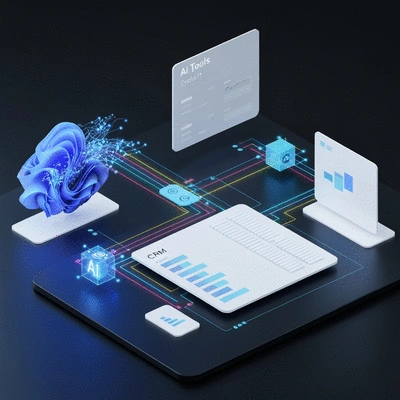Revive Your Database for Profit

Have you considered the untapped potential lying within your dormant leads? Reactivating these prospects could be a game-changing strategy for your business.
What You Will Learn
- Database reactivation leverages AI to engage dormant leads, enhancing communication strategies.
- Identifying and tailoring messages to dormant leads increases engagement and conversion rates.
- Data analytics plays a pivotal role in understanding customer behaviors, guiding marketing strategies.
- Implementing AI tools with your CRM can streamline the outreach process and improve efficiency.
- Consistent re-engagement efforts can turn dormant leads into loyal customers, boosting revenue.
AI-Powered Database Reactivation: Key Benefits and Implementation Steps
This visual highlights the core advantages of reactivating dormant leads with AI and outlines a practical, step-by-step approach to integrating AI tools with your CRM for effective campaigns.
Benefits of Reactivating Dormant Leads with AI
Cost-Effective
Cheaper than acquiring new customers, maximizing ROI on existing lead investments.
Higher Conversion Rates
Existing leads are familiar with your brand, leading to better engagement.
Builds Loyalty
Re-engaging customers can turn them into long-term brand advocates.
Unlock Revenue
Taps into potential revenue from existing leads that might otherwise be overlooked.
5 Steps to Integrate AI with Your CRM for Reactivation
1. Assess Current CRM
Evaluate existing CRM features to identify AI enhancement opportunities.
2. Choose AI Tools
Select tools for lead scoring, segmentation, and automated messaging aligned with goals.
3. Integration Setup
Ensure seamless data transfer between AI tools and CRM with IT or vendor help.
4. Train Your Team
Familiarize your team with new tools and processes to effectively utilize AI insights.
5. Monitor & Optimize
Continuously track performance metrics and make adjustments for improved outcomes.
Understanding AI-Powered Database Reactivation and Its Relevance
As a business strategist at My AI Business Coach, I often emphasize the transformative nature of AI in various business processes. One area that stands out is database reactivation. This involves revitalizing interactions with dormant leads who have previously expressed interest but have since gone cold.
So, what exactly does database reactivation mean in the context of AI? Simply put, it leverages artificial intelligence to identify and engage potential customers who haven’t interacted with your business in a while. By using data analytics, we can tailor our outreach efforts, making them more efficient and effective.

Defining Database Reactivation in the Context of AI
At its core, database reactivation is about rekindling lost connections. AI plays a crucial role here by analyzing past customer behaviors and preferences. This allows businesses to create targeted, personalized campaigns that resonate with each lead.
- Identifying Dormant Leads: AI can sift through vast amounts of data to pinpoint leads who haven’t engaged recently.
- Tailoring Messaging: By understanding past interactions, we can craft messages that speak directly to the needs and preferences of those leads.
- Automating Outreach: AI tools can automate the outreach process, ensuring that no lead is left behind as we work to reactivate them.
Utilizing AI in database reactivation not only saves time but enhances the overall effectiveness of the marketing efforts, something that every business should consider!
The Importance of Reactivating Dormant Leads for Business Growth
Not re-engaging dormant leads can significantly hinder business growth. Reactivating these leads often requires far less effort compared to acquiring new customers. In fact, studies show that reactivating existing leads can lead to increased sales without the high costs associated with new customer acquisition. As highlighted in the Federal Reserve's 2023 Annual Report, understanding economic behavior and market dynamics is crucial for strategic business decisions, supporting the idea that focusing on existing assets like dormant leads can yield substantial returns.
- Cost-Effective: It’s generally cheaper to reach out to existing leads than it is to bring in new prospects.
- Higher Conversion Rates: Existing leads are already familiar with your brand, which often leads to higher conversion rates.
- Building Loyalty: Engaging dormant customers can turn them into loyal advocates for your business.
By focusing on dormant leads, businesses can unlock a wealth of potential revenue that might otherwise go unnoticed.
The Role of Data Analytics in Enhancing Reactivation Efforts
Data analytics is a game-changer when it comes to reactivation efforts. It allows businesses to dive deep into customer data, uncovering valuable insights that can shape marketing strategies. Through advanced analytics, we can determine patterns, preferences, and behaviors that inform our approach. The Financial Research Report emphasizes the importance of robust data analysis for strategic decision-making, aligning with how businesses can leverage analytics for more effective reactivation campaigns.
- Insightful Reporting: Analytics tools provide comprehensive reports that highlight the most effective strategies.
- Segmentation: With data analytics, we can segment leads based on their behavior, tailoring our outreach accordingly.
- Predictive Modeling: Utilizing predictive analytics helps identify which dormant leads are most likely to engage again.
Incorporating data analytics into our reactivation efforts not only increases our efficiency but also enhances our understanding of customer needs—making it an essential strategy for any business!
Engage with Us!
Have you ever reactivated a dormant lead? What strategies worked best for you? Share your experiences with us below:
Implementing AI-Powered Database Reactivation Strategies
At My AI Business Coach, we understand that the potential for revenue growth often lies in the leads you already have. Implementing AI-powered database reactivation strategies can dramatically change your business landscape, allowing you to tap into those dormant leads and turn them into profit. Here’s a practical approach to getting started!
To effectively bring these leads back into the fold, it’s crucial to integrate AI tools with your existing Customer Relationship Management (CRM) systems. This integration will allow you to leverage data analytics for targeted outreach and personalized experiences. Let’s dive into the steps you can take to harness these technologies.

A Step-by-Step Guide to Integrating AI Tools with Your CRM
The integration of AI tools into your CRM system can initially seem overwhelming, but breaking it down into manageable steps can make the process smoother. Here’s how you can do it:
- Assess Your Current CRM: Evaluate the features and capabilities of your existing CRM. Identify areas where AI can enhance functionality.
- Choose the Right AI Tools: Select AI tools that align with your business goals. Look for options that facilitate lead scoring, customer segmentation, and automated messaging.
- Integration Setup: Work with your IT team or a third-party vendor to integrate the chosen AI tools with your CRM. Ensure seamless data transfer between systems.
- Train Your Team: Conduct training sessions for your team to familiarize them with the new tools and processes. Empower them to utilize AI insights effectively.
- Monitor and Optimize: Continuously track performance metrics to assess the effectiveness of your AI strategies. Make adjustments as needed to improve outcomes.
Following this guide will set a solid foundation for your reactivation campaigns, ensuring that your team can work efficiently and effectively.
Best Practices for Running Effective AI Reactivation Campaigns
Once your AI tools are in place, the next step is to run successful reactivation campaigns. Here are some best practices that can help you maximize your efforts:
- Personalization: Use AI to tailor messages based on past interactions. Personalized communication can significantly increase engagement levels.
- Test and Learn: Experiment with different messaging, channels, and offers. Monitor what resonates best with your audience and adapt your strategies accordingly.
- Segment Your Audience: Use data analytics to segment dormant leads into groups. This allows for targeted campaigns that appeal to specific interests or behaviors.
- Follow Up Consistently: Don’t just reach out once and forget. Implement a follow-up strategy to keep the conversation going and nurture relationships.
By adhering to these best practices, you can create campaigns that not only reactivate leads but also foster long-term relationships with your clients.
Utilizing Marketing Automation for Streamlined Reactivation Efforts
Marketing automation is a game-changer when it comes to efficiency in your reactivation efforts. By automating certain processes, you can save time and focus on crafting compelling messages. As highlighted in the FSOC 2023 Annual Report, technological advancements play a critical role in optimizing processes and improving outcomes across various sectors, including marketing.
- Email Drip Campaigns: Automate a series of emails designed to re-engage dormant leads over time.
- AI-Driven Insights: Use automation tools to analyze customer behavior and adjust campaigns in real-time based on performance.
- Task Reminders: Set automated reminders for your team to reach out to specific leads, ensuring consistent follow-up.
Implementing marketing automation can streamline your efforts and help ensure that no opportunity is missed. By focusing on efficiency, you can maximize your impact while minimizing manual workload.
Frequently Asked Questions About AI-Powered Database Reactivation
What is AI-powered database reactivation?
AI-powered database reactivation involves using artificial intelligence to identify and re-engage dormant leads who have previously shown interest in your business but have become inactive. AI analyzes past interactions and behaviors to tailor personalized outreach campaigns.
Why is reactivating dormant leads important for business growth?
Reactivating dormant leads is crucial because it is more cost-effective than acquiring new customers and often leads to higher conversion rates. Existing leads are already familiar with your brand, and re-engagement can foster loyalty and unlock potential revenue.
How does data analytics enhance reactivation efforts?
Data analytics is essential for reactivation as it provides insights into customer behaviors, preferences, and patterns. It enables businesses to segment leads effectively, craft targeted messages, and use predictive modeling to identify leads most likely to re-engage.
What are the key steps to integrate AI tools with a CRM for reactivation?
The key steps include: assessing your current CRM's capabilities, choosing the right AI tools for lead scoring and segmentation, setting up seamless data transfer integration, training your team on new tools, and continuously monitoring and optimizing performance metrics.
What are some best practices for running effective AI reactivation campaigns?
Best practices include personalizing messages based on past interactions, testing different messaging and offers, segmenting your audience for targeted campaigns, and consistently following up to nurture relationships with reactivated leads.
Recap of Key Points
Here is a quick recap of the important points discussed in the article:
- Database Reactivation: Revitalizes interactions with dormant leads using AI to identify and engage them effectively.
- Cost-Effective Growth: Reactivating existing leads is generally cheaper and often leads to higher conversion rates.
- Data Analytics Utilization: Advanced analytics help identify patterns and segment leads, enhancing targeted marketing efforts.
- Step-by-Step Integration: Assessing your CRM, choosing the right AI tools, and training your team are crucial for successful implementation.
- Best Practices: Personalization, consistent follow-ups, and audience segmentation are key strategies for effective AI reactivation campaigns.
Popular Posts
 Have you ever wondered how artificial intelligence can reshape consumer behavior and decision-making
Have you ever wondered how artificial intelligence can reshape consumer behavior and decision-making
 As the digital landscape evolves, small businesses are discovering that artificial intelligence is n
As the digital landscape evolves, small businesses are discovering that artificial intelligence is n
 Did you know that personalized marketing can lead to a revenue increase of up to 30%? In an era wher
Did you know that personalized marketing can lead to a revenue increase of up to 30%? In an era wher
 Are you aware that reactivating dormant customers can significantly enhance your business growth? Ma
Are you aware that reactivating dormant customers can significantly enhance your business growth? Ma
